Are you tired of going back and forth with “does X time work for you?” emails? Not only are they a waste of time, but they can also delay calls or meetings or even lead to cancellations.
So what’s the alternative?
A standard availability calendar lets you share empty times on your calendar to let the other person choose a suitable time. A smart availability calendar helps you accommodate your potential client’s needs while considering your preferences.
What is an availability calendar?
In the business world, an availability calendar is a calendar that shows available days and time slots you can send to prospects, stakeholders, partners, or team members to schedule meetings or calls. (Rental businesses also use availability calendars to lease rooms, houses, and vehicles.)
It can be formatted in multiple ways but often follows the typical monthly or weekly calendar format.
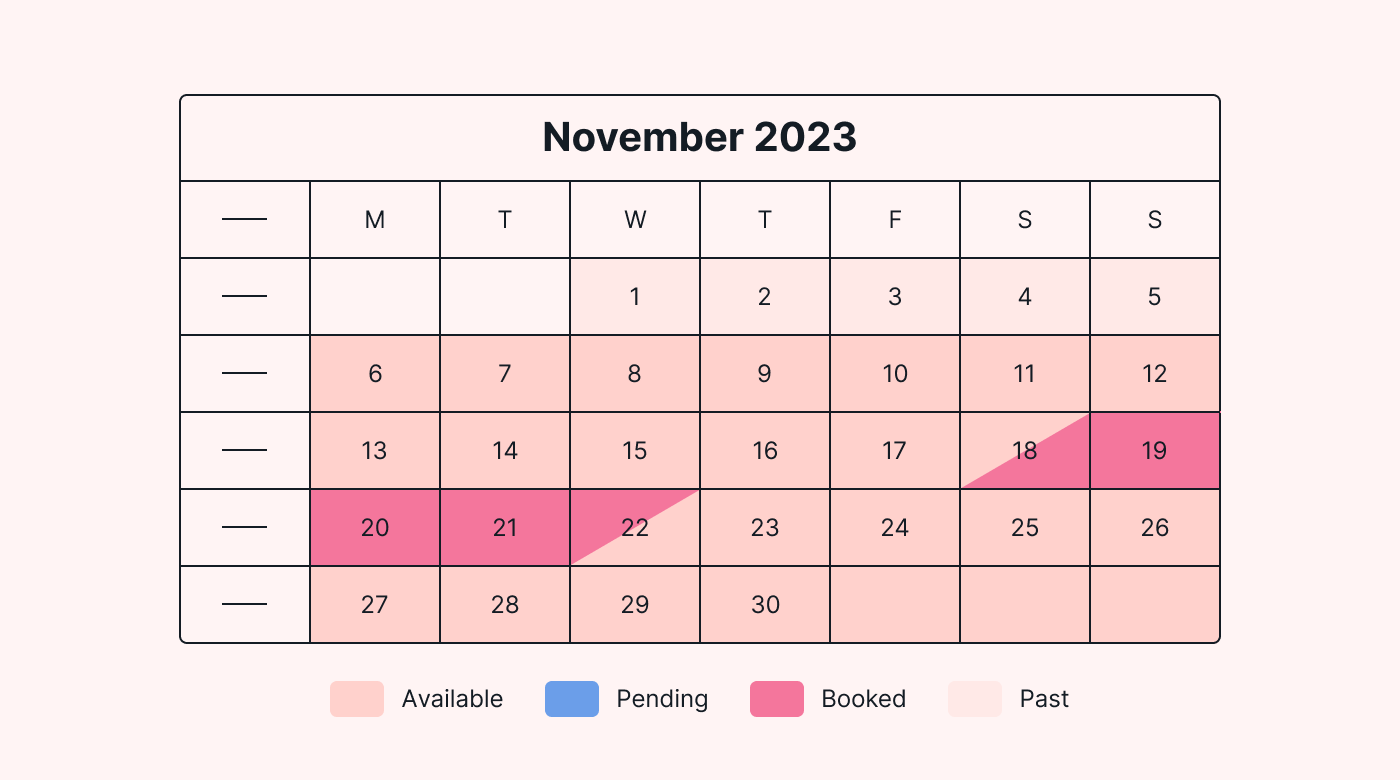 |
A physical calendar might work in a single-office small business, but issues quickly arise at a larger scale — different time zones, conflicting meeting hours, and more.
That’s why most companies have long since transitioned to digital alternatives like Google Calendar or Outlook Calendar. Digital calendars are interactive, changing in real time as people on your team add tasks or meetings and invite people.
Interactive calendars come with many benefits — adapting time zones automatically, making cross-office or WFH collaboration smoother, and improving visibility for the whole team.
When it comes to availability, they’re a good visual indicator, but you probably don’t want to share the inner workings of your team with every prospect. Google and Outlook calendars include some basic appointment scheduling tools, but they’re not great. In these calendars, you have to set times and accept requests manually.
But not all availability calendars are as rigid and inflexible.
What makes a smart availability calendar different?
A smart availability calendar uses AI or machine learning to better adapt to your needs and those of your clients. It shows availability based on existing tasks in your work calendar — even connecting to third-party software like Google Calendar.
But what sets it apart is how it distinguishes certain types of tasks — unfixed vs. important and fixed, making your calendar more flexible.
For example, Motion’s availability calendar uses an algorithm to schedule non-fixed tasks around meetings.
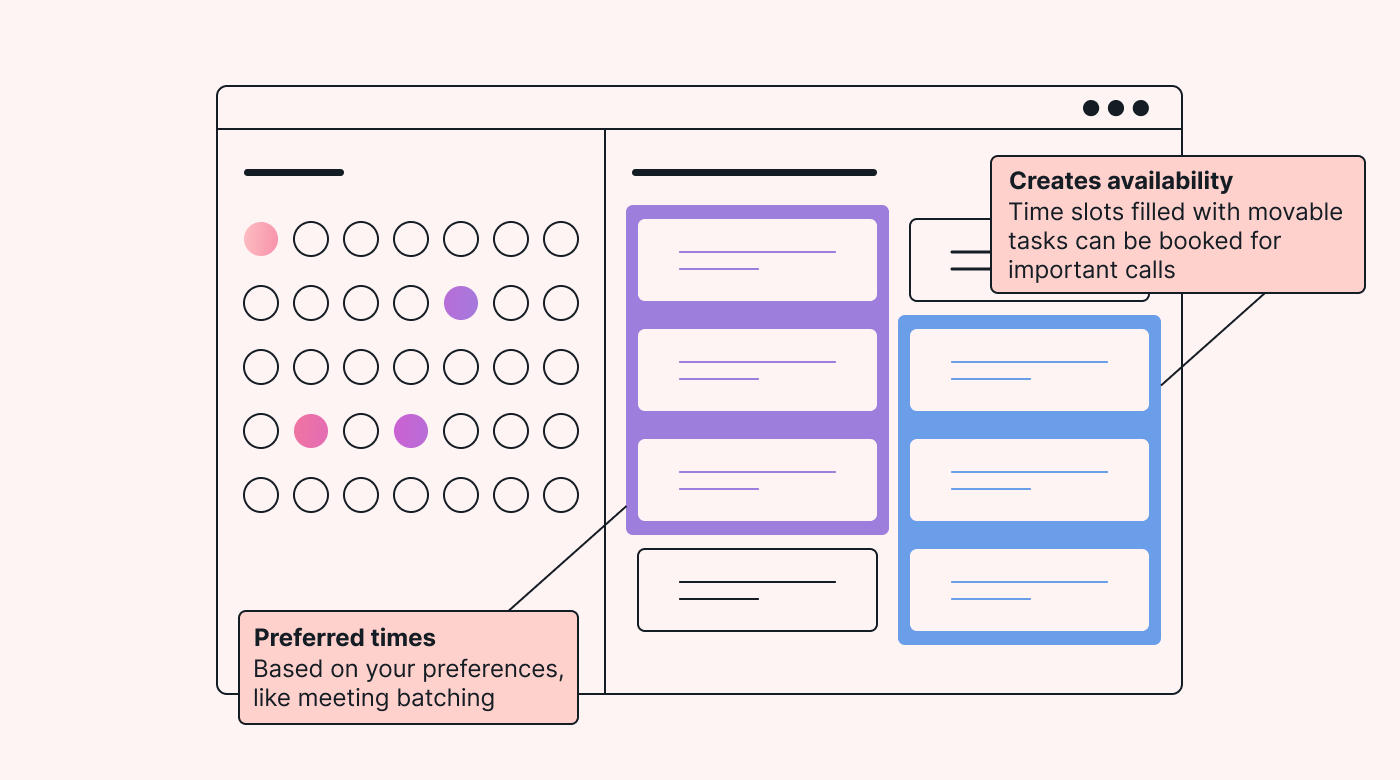 |
This can be particularly helpful if prospects and clients are in various time zones. The more flexible you can be, the faster you can jump on a call with a prospect to close a deal.
If a prospect struggles to find a time that works for them, you risk that they just move on to another competitor. Speed matters a lot in B2B sales. For example, fast responses drive more conversions — responses within the first five minutes drive 8x higher conversion rates.
In the same way, making it easy to book a demo or sales call as early as possible is crucial. The longer they have to wait, the higher the chances they will book another call. If that call goes well, you’ll get ghosted and kiss your chances of landing that deal goodbye.
Here are some of the features of a smart availability calendar that help you avoid this:
- Flexible scheduling around non-fixed tasks, for example, writing new copy for a sales page.
- Automatically highlighting preferred times to batch meetings, giving you larger time blocks for focused work.
- Multiple different booking templates with varying lengths depending on the type of call or meeting — product demo, sales call, 1-on-1 meeting, and more.
How to create the ideal availability calendar with Motion
Enough theory. Let’s examine how Motion’s availability calendar can make your life easier with smart features like automatic rescheduling.
Create a custom availability calendar/meeting booking site
Motion lets you create a dedicated booking site in just a few clicks. Potential clients, teammates, stakeholders, and others can then visit this site and book a time.
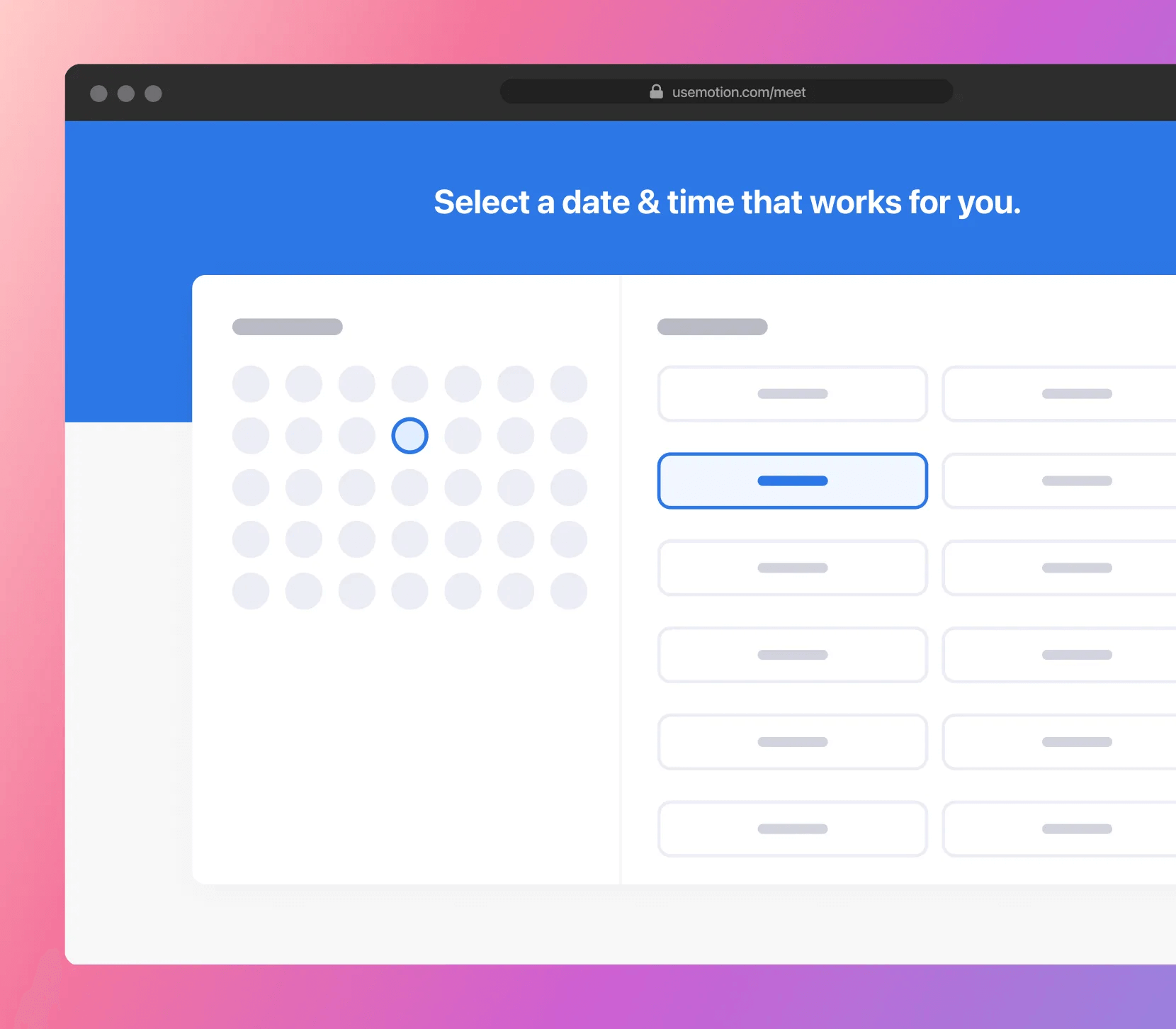 |
You can customize the page, including various information about the type of meeting or call available for booking. And you can also include multiple types of potential calls or meetings for booking.
But be careful not to include too much information. A little goes a long way when it comes to getting a potential client to book a call. You don’t want to confuse them with options or text when you’ve convinced them to book a call. Make it clear what they’re booking, but let them do so without making multiple decisions or reading a wall of text.
Create different templates for different channels and people
Not every call should be the same length or require the same amount of pre-call information. Motion makes it easy to create different templates for various use cases.
(Creating separate pages makes the process easier on clients and prospects so they don’t have to choose from drop-down menus or fill out multiple forms.)
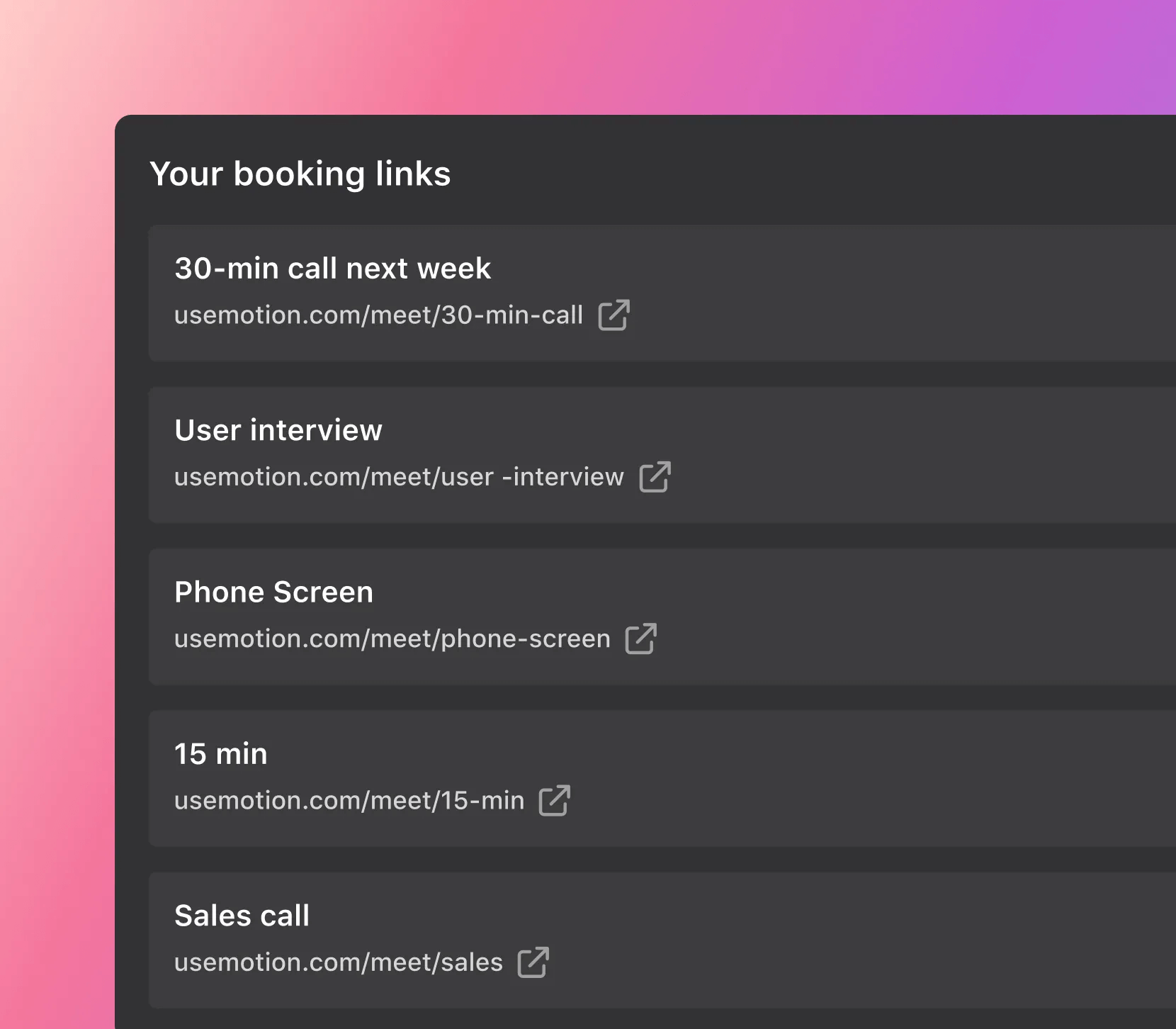 |
Once you’ve created the links, you can easily see all your booking links within your profile. For best results, include different links in different automated campaigns and emails.
Set your schedule and preferences beyond availability
Not an early bird? Make sure that the automated scheduler doesn’t lock in an 8 am meeting by setting a concrete schedule.
You can also indicate preferred times beyond the actual schedule, and Motion will automatically highlight your preferred times to people using the booking calendar.
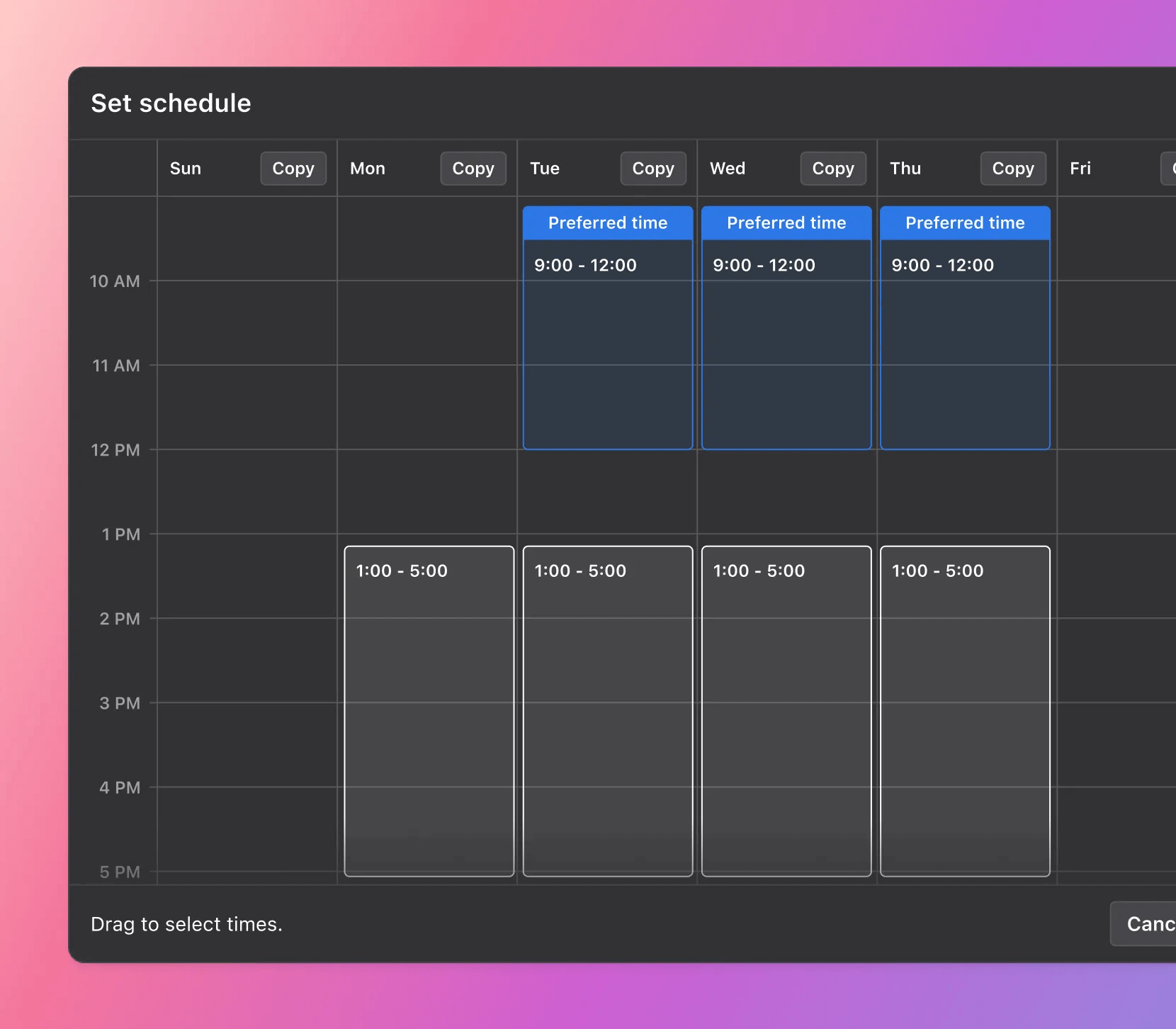 |
Of course, the availability calendar also considers what is in your actual calendar for each day. For example, they won't be suggested if your preferred meeting times are already filled with fixed tasks.
On the other hand, Motion will schedule around non-fixed tasks if you or a sales rep have little space to work with. This helps you nail down calls faster without back-and-forth emails.
Turn on automatic back-to-back meeting scheduling
If you enable this function, Motion will automatically try to schedule meetings back-to-back to give you more time to do focused work. If you already have a meeting booked, it will mark time slots before and after it as preferred.
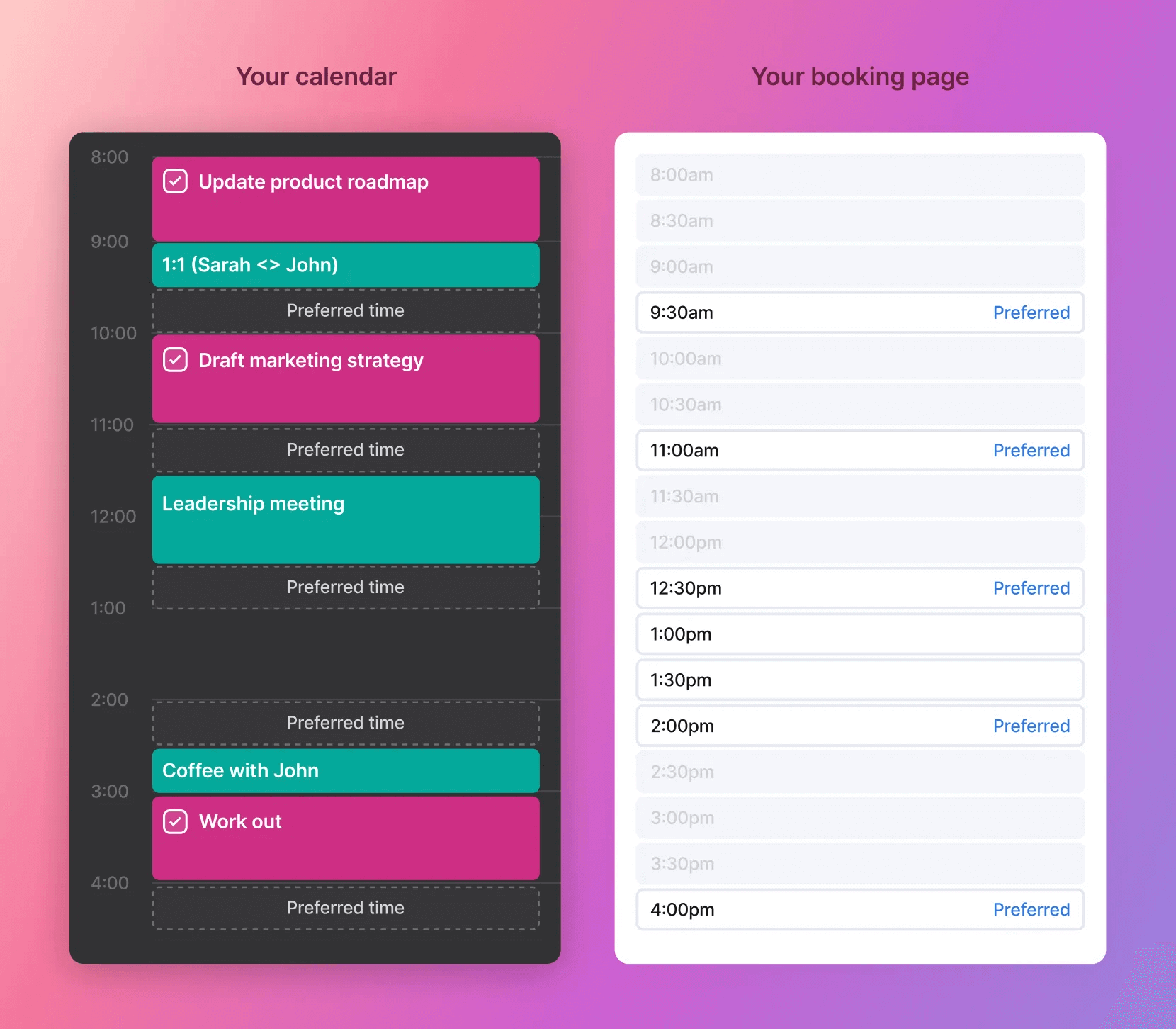 |
To make this as consistent as possible, create a policy for employees to select the preferred times when booking meetings. This can help you find the time to do high-quality, focused work in your busy schedule.
Of course, you can’t force potential clients to book at your preferred times, but accommodating their needs is crucial. You can easily delegate calls from less important prospects to keep your time blocks sacred.
Optimal meeting scheduling without needing to send a single email
Through a mix of a fixed schedule, preferences, back-to-back meetings, and flexible rescheduling of non-fixed tasks, Motion makes call setting easy. Essentially, Motion does what it can to schedule each meeting and call at the perfect time for both sides.
The result of all this is pronounced: you get meetings scheduled efficiently without sending any emails yourself. To experience how smoothly our availability calendar works, sign up for a free trial of Motion today.
Optimize your entire team’s calendars with Motion
What differentiates Motion from other availability calendar solutions is that it optimizes your team’s calendars. It doesn’t just help them book meetings effectively.
For example, scheduling a non-negotiable team meeting on a bug fix will make room for it in your team member’s schedule.
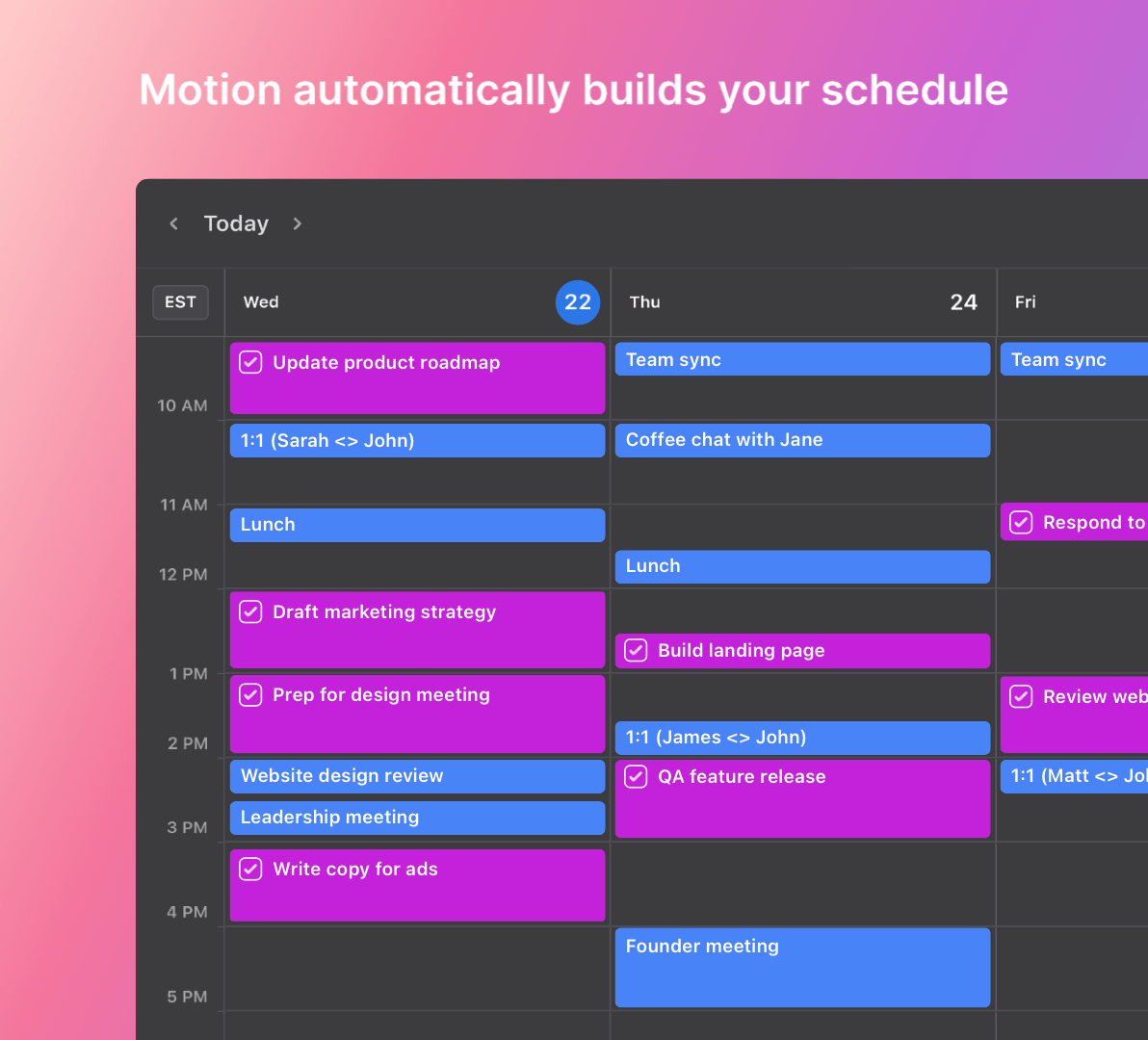 |
This helps your team spend less time planning and more time working.
Create tasks and let Motion schedule them for you
Say goodbye to scanning calendars and picking dates and time slots for every new task. With Motion, there’s no need to spend time trying to fit a new task into your schedule. You just need to create the task and set the priority, deadline, and dependencies, and Motion takes care of the rest.
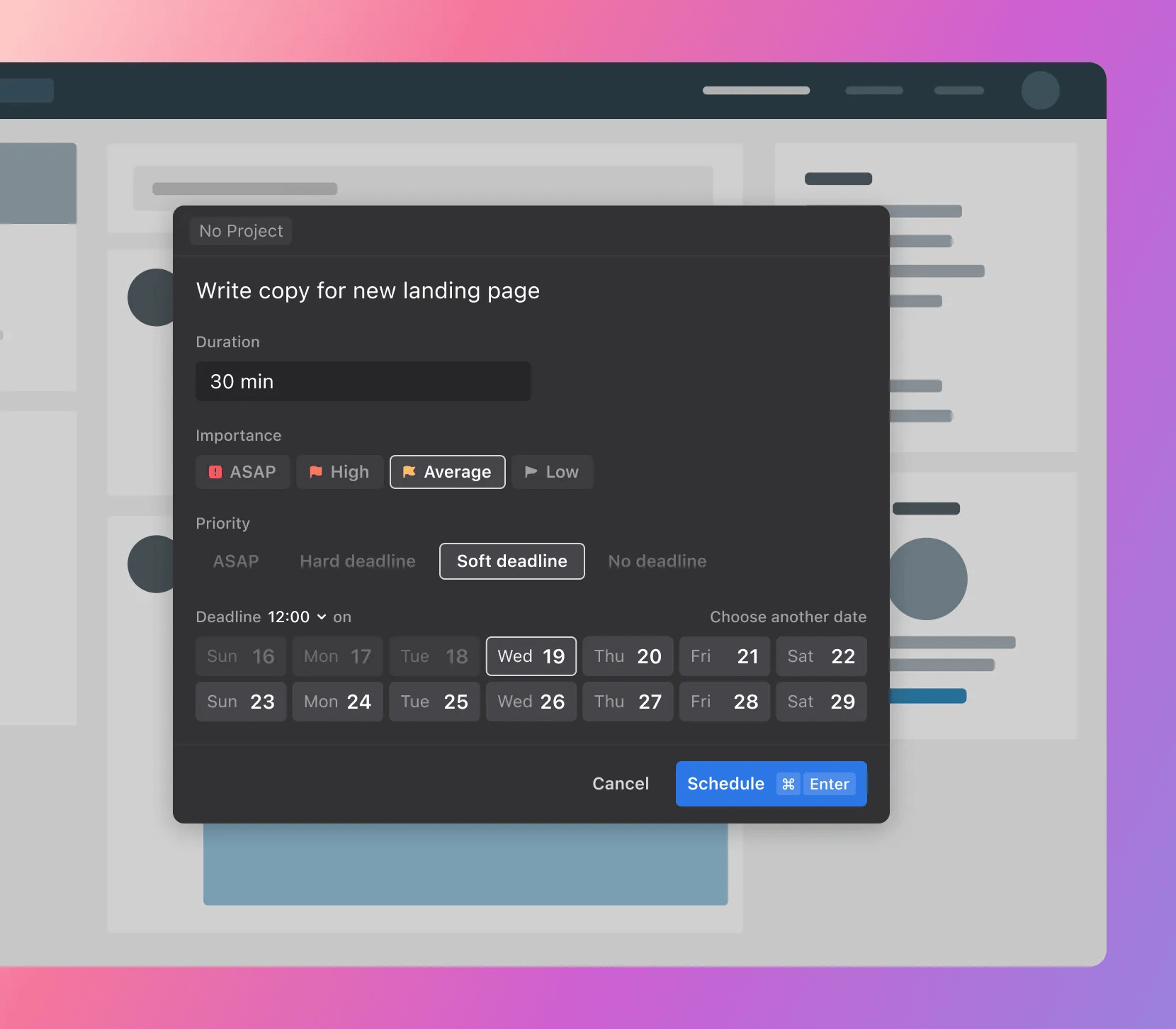 |
We let you set different priority levels because we understand that plans and goals change. This way, you can automatically make room for last-minute emergencies without needing to comb through your calendar each time.
In most teams, precious hours get lost every week due to last-minute planning and rescheduling. Many managers proudly speak of “putting out fires.” In our experience, this is often a pseudonym for micro-management, spending hours on meetings and communication (and making team members do the same).
The thing is, you don’t have to spend hours adjusting your plan each week. Yes, priorities change. Some tasks take longer than expected. No plan survives very far past the project launch day. But that doesn’t mean you need to handle every minute change of plan yourself — or worse, involve important team members in that process.
Motion makes it possible to tackle these issues from a new angle. Our AI calendar assistant helps you create a more flexible and effective working culture, less weighed down by confusion and last-minute planning, and more focused on doing. After all, the schedules create themselves. You just need to input the tasks as they come in and then actually do them.
The weighted scheduling means your team members always work on the highest-priority tasks. There’s no guesswork involved. Their calendar is an actual representation of what’s required of them for the day. This feature is the main reason companies boost productivity by 20%, on average, when switching to Motion.
Schedule recurring tasks
Of course, you can also schedule recurring tasks (like a daily standup meeting) into everyone’s calendar. If it’s a low-priority internal meeting, you can set the priority level to “try to finish.” Essentially, that will allow more urgent tasks to get priority over the meeting.
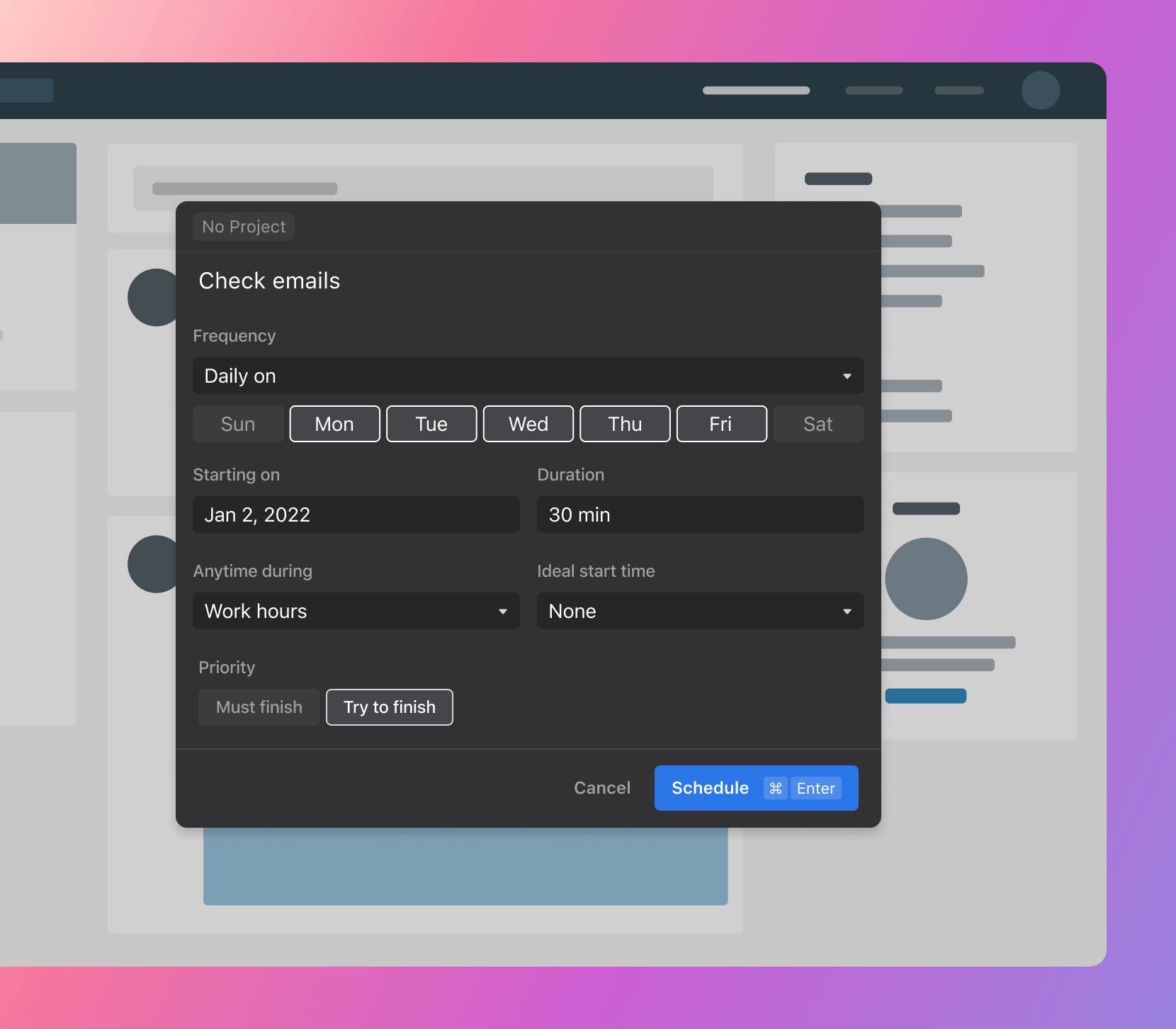 |
Tag higher-priority recurring tasks and meetings with “must finish” and give them an ideal start time.
Get a high-level overview with project views
Motion doesn’t just help you plan your team's day-to-day tasks and schedules. Kanban boards and our project view make planning larger and more complex projects easy.
These views also help you visualize the project's progress and quickly make any necessary adjustments if anything unforeseen arises.
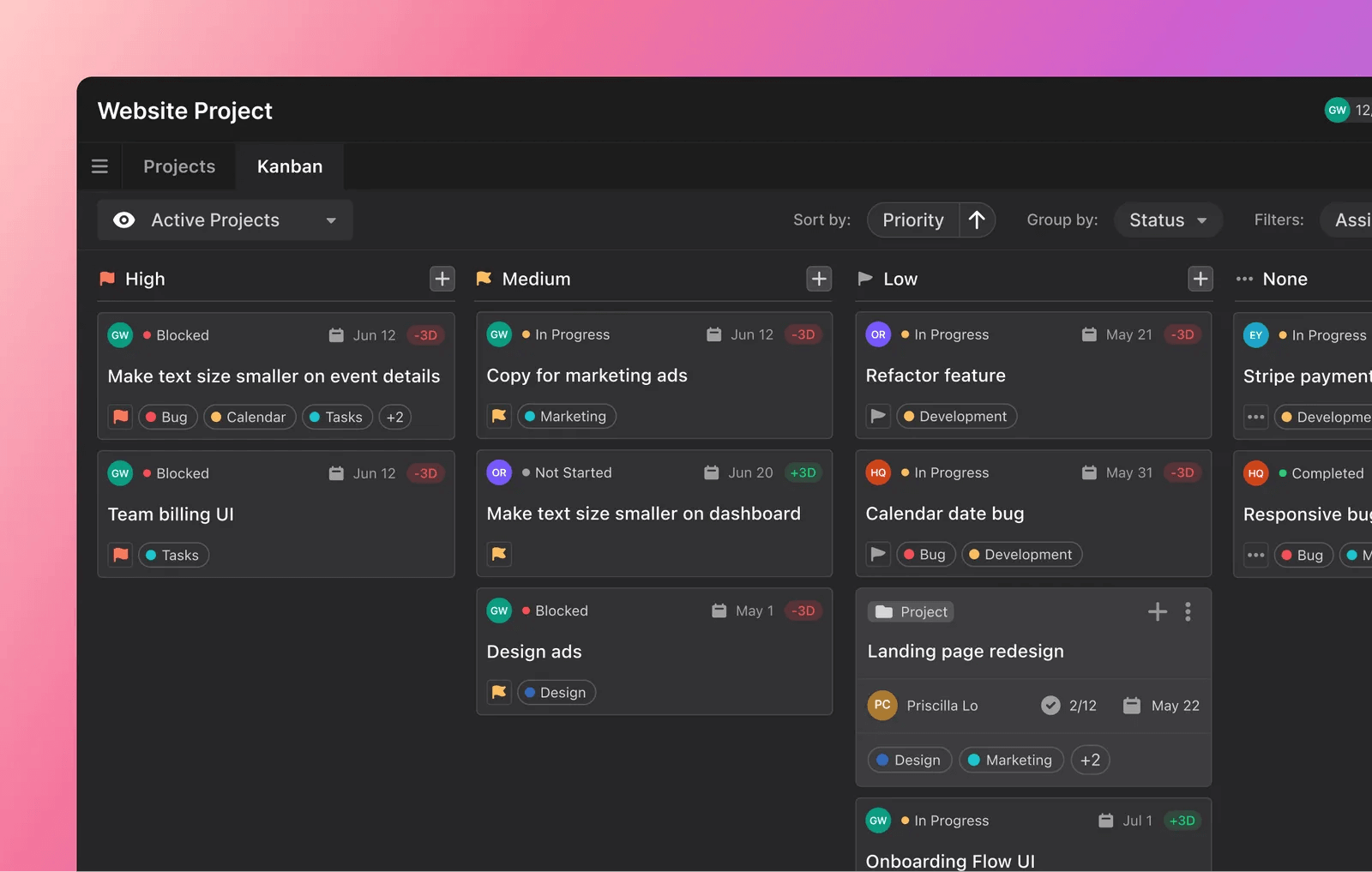 |
You can sort the task by priority, status, and categories and use several smart filters to help you get the insights you need at a glance.
Motion isn’t just a smart group calendar with an algorithm that helps you find the ideal slot for new tasks. It’s an AI-powered platform that makes planning and doing work easier daily.
How Motion helped Sparkmate reduce distractions and ship work faster
Before finding Motion, Morgan Pelissier, Co-Founder of Sparkmate, struggled to find a work management solution for his company. After testing multiple solutions, his co-founder Max typically concluded, “No, not useful.”
Sparkmate is a company in a uniquely fast-moving environment — their business model is to help entrepreneurs develop tech products from idea to launch in thirty weeks.
Efficiency is a key to success in that kind of business. So Morgan came up with a rule to promote that, “I have a rule in my company. Everything you do twice, you automate.” He is a big believer in automation as a way to help small teams have the output of much larger teams.
But he was having a hard time automating task delegation, prioritization, and time management, even though they’re tasks he dealt with on a daily basis. He uses the time management strategy of time blocking to maximize his output of high-quality work.
But before Motion, he just hadn’t found another solution that could automatically create a time-block-friendly schedule for him. With Motion, he must input a new task with priorities and other criteria and let the algorithm handle the rest.
 |
Motion also impressed his picky co-founder Max, who had shut down all the previous solutions Morgan suggested. With it, they no longer had to communicate to reorganize their schedules as priorities changed actively. Motion simply figures out where everyone has room and slots in the task or meeting into that space (or moves non-fixed tasks out of the way to accomplish that).
It also solved Morgan’s challenge with delegation — with a clear overview of everyone’s schedules, he can easily click a button to send a task to one of his teammates. The priority and deadline settings carry over, and Motion automatically adds the task to that person’s schedule.
Morgan says, “Motion allowed me to automate organization.” As a result, he can focus more on shipping his most important deliverables — and so can everyone else on the team. This has allowed Sparkmake to ship faster and work with more direction and less stress.
Let Motion handle your meeting scheduling and optimize your calendar
Even if you’re just looking for an availability calendar, Motion delivers unique features that make it a smoother experience for everyone involved. Creating a booking site for different types of calls and meetings is a breeze. Back-to-back meeting batching, schedule preferences, and automatic task rescheduling help you schedule calls and meetings at the times that suit you best.
But as you’ve seen throughout this post, availability and meeting scheduling only scratch the surface of what Motion can do. Our automatic scheduling algorithm takes the tedium out of planning and delegation and makes sure everyone’s always working on tasks that matter.
Motion is a unique productivity platform that can help your team work more and fuss less. To see how it can transform your team's work, sign up for our 7-day free trial today.
Say goodbye to issues like team members being confused about what to do next or never finding the time to do deep work.
Say goodbye to issues like team members being confused about what to do next or never finding the time to do deep work.





